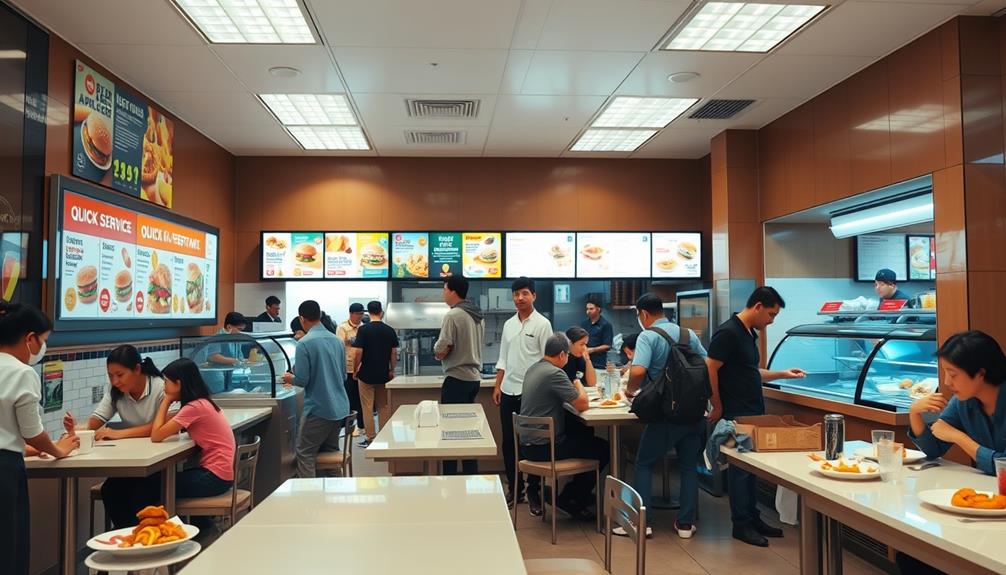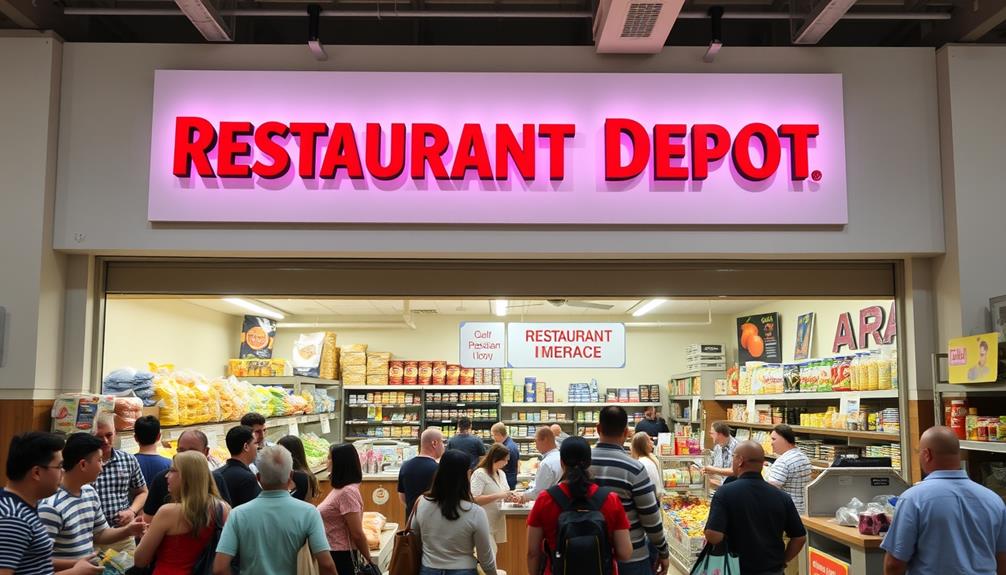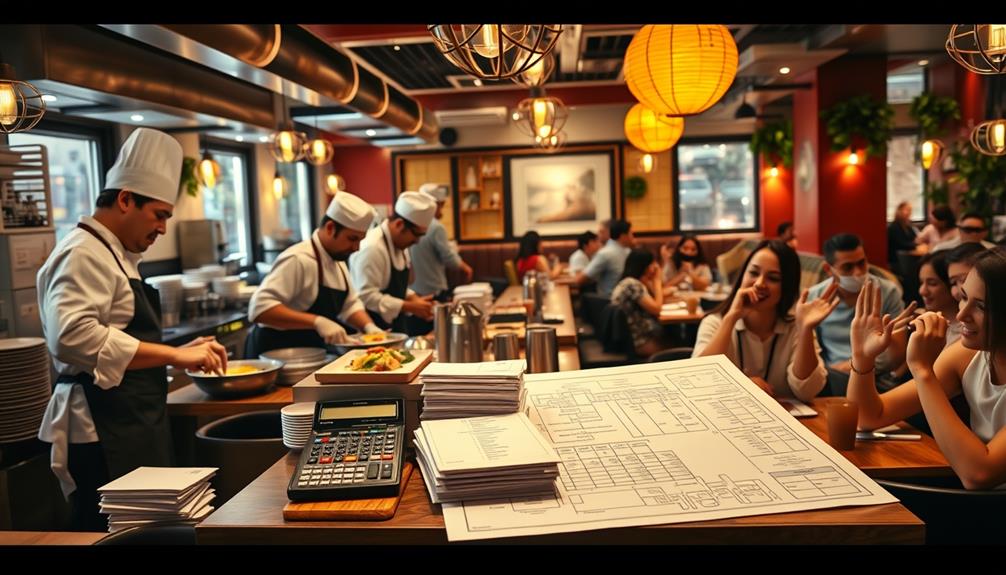A restaurant can earn a maximum of three Michelin stars. Each star indicates a different level of culinary excellence. One star means the restaurant is "very good," while two stars signify "excellent cooking worth a detour." Three stars represent "exceptional cuisine worth a special journey." This star rating reflects the quality of the food, cooking techniques, and creativity involved, rather than the decor or service. Michelin stars are awarded after thorough inspections by anonymous reviewers who evaluate each restaurant multiple times a year. If you're curious about what it takes to achieve these prestigious stars, there's much more to explore.
Key Takeaways
- A restaurant can earn a maximum of three Michelin stars, indicating varying levels of culinary excellence.
- One star signifies a "very good restaurant," while two stars denote "excellent cooking worth a detour."
- Three stars indicate "exceptional cuisine worth a special journey," showcasing outstanding culinary skill.
- Star ratings are reassessed annually, allowing restaurants to gain or lose stars based on consistent quality.
- The Michelin Guide is recognized globally, with 145 restaurants holding three stars as of 2024.
Michelin Star System Overview

The Michelin star system is a prestigious ranking that can elevate a restaurant's status in the culinary world, with a maximum of three stars up for grabs. Each star signifies a different level of excellence, guiding diners toward exceptional cuisine. One star indicates a "very good restaurant," while two stars denote "excellent cooking worth a detour." The coveted three stars mean the restaurant offers exceptional cuisine, worth a special journey.
This ranking is highly respected in the culinary community and serves as a benchmark for chefs aiming to showcase their skills and creativity through their dishes. The rigorous standards of the Michelin guide often inspire chefs to innovate and push the boundaries of culinary artistry, creating an ever-evolving dining experience for guests seeking personal growth and development resources.
This star rating system, established in the early 20th century and refined over the years, focuses solely on the quality of food and cooking techniques. It's essential to understand that factors like decor or service don't influence the awarding of Michelin stars. Instead, starred restaurants are scrutinized for their culinary prowess, consistency, and overall performance.
A restaurant's star rating can fluctuate annually, meaning it can gain or lose stars based on its ongoing commitment to excellence. This dynamic nature keeps chefs and restaurateurs working toward the highest standards, ensuring that guests experience the best in culinary artistry.
In the world of fine dining, Michelin stars remain the ultimate benchmark for quality and dedication to excellent cooking.
History of Michelin Stars
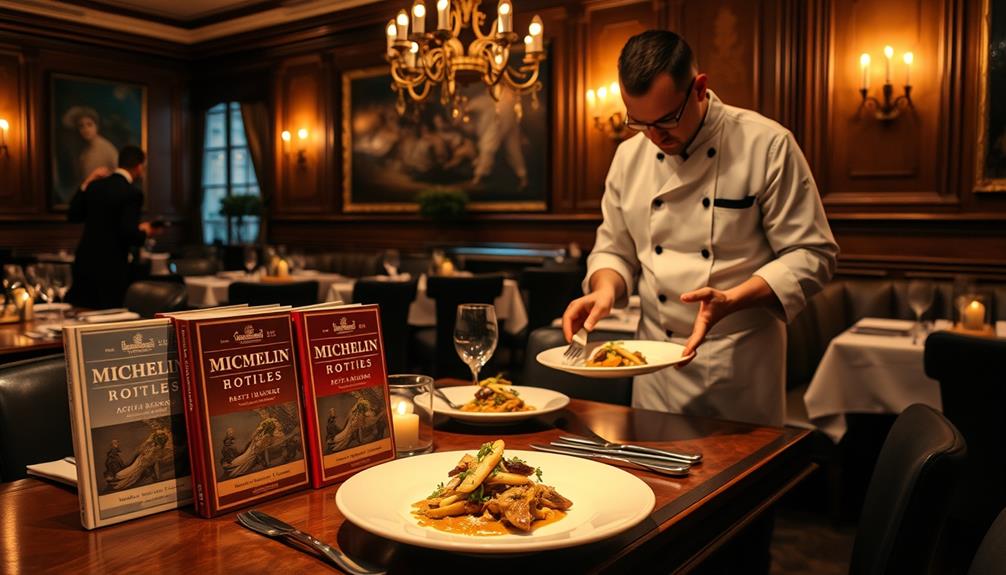
The Michelin Guide started in 1926, setting the stage for what would become a global standard in dining excellence.
The influence of the guide has spurred restaurants worldwide to elevate their culinary offerings and aim for recognition, similar to how Noble Gold offers a range of precious metal investment options.
You'll see how the star rating system evolved from a single star to the prestigious three-star distinction and its impact on the culinary world.
Understanding this history helps you appreciate the significance of those coveted stars in today's dining scene.
Origin of Michelin Guide
Established in 1900 by the Michelin tire company, the Michelin Guide aimed to promote automobile travel and boost tire sales by providing useful maps and restaurant listings. This innovative approach laid the groundwork for what would become one of the most prestigious culinary guides in the world.
The guide's emphasis on quality and excellence parallels the importance of having a solid budget in managing one's financial health, as both require attention to detail and a commitment to improvement.
In 1926, the Michelin Guide introduced its star system, initially awarding one star to fine dining establishments. This system evolved into the iconic three-star rating in 1931, distinguishing between excellent, exceptional, and extraordinary dining experiences.
The origins of the Michelin star system set a high standard for culinary excellence, influencing chefs and restaurants globally.
Over the decades, the Michelin Guide expanded internationally, with the first Michelin Stars awarded in the U.S. occurring in 2005, starting with New York City.
In 1955, the guide introduced the Bib Gourmand, recognizing restaurants that offer high-quality cuisine at moderate prices, complementing the Michelin star ratings.
Today, the Michelin Guide covers 37 countries, celebrating culinary innovation and excellence in diverse dining styles and global cuisines.
Star Rating Evolution
This evolution highlights the Michelin Guide's adaptability, as it now encompasses a vast array of culinary styles beyond French cuisine. Star ratings are reassessed annually, guaranteeing that only those restaurants consistently delivering high-quality dining experiences retain their stars.
Here's a quick overview of the Michelin star rating system:
| Star Rating | Description | Year Introduced |
|---|---|---|
| One Michelin Star | A very good restaurant in its category | 1926 |
| Two Michelin Stars | Excellent cooking, worth a detour | 1931 |
| Three Michelin Stars | Exceptional cuisine, worth a special journey | 1931 |
| Awarded to Restaurants | Total of 2,817 globally recognized | Ongoing |
| Annual Reassessment | Guarantees quality and consistency | Ongoing |
This structured approach guarantees that the Michelin stars remain a symbol of culinary excellence.
Historical Impact on Dining
Michelin stars have immensely shaped the dining landscape since their introduction, pushing chefs and restaurants to elevate their culinary offerings. Established in 1926, the Michelin star system evaluates food quality, with a maximum of three stars awarded to signify exceptional culinary excellence. The introduction of the three-star system in 1931 created a benchmark for fine dining, indicating which restaurants offer cuisine worth a special journey.
The rigorous standards of the Michelin Guide have parallels with the luxury cruises that emphasize exclusive experiences and exceptional service.
Over the decades, the Michelin Guide expanded beyond France, influencing global dining trends and raising culinary standards across various countries. Achieving Michelin stars has notably impacted restaurant reputation and success. Many chefs and restaurateurs endeavor for this prestigious recognition, knowing it enhances visibility and attracts a dedicated clientele.
As of 2024, a total of 145 restaurants worldwide hold three Michelin stars, reflecting the rigorous and evolving standards of the Michelin Guide. The quest for these stars has fostered a culture of innovation and excellence in the culinary world, encouraging chefs to continuously refine their skills and push the boundaries of fine dining.
Ultimately, the historical impact of Michelin stars has transformed how we perceive and experience dining, making it an essential part of culinary history.
Inspection and Evaluation Process

When it comes to the Michelin star evaluation, there's a rigorous inspection process that guarantees only the best restaurants make the cut. This multi-step process involves anonymous inspectors visiting your restaurant multiple times throughout the year. They evaluate your offerings in different seasons to verify they consistently meet the high standards expected for Michelin stars.
The importance of content relevance and authority in the culinary world parallels the rigorous standards set by Michelin's inspectors, as both demand a commitment to excellence.
The evaluation focuses primarily on the quality of ingredients and the mastery of cooking techniques. Inspectors not only assess the food but also look for the chef's personality reflected in the dishes, overall value for money, and that all-important consistency across visits.
You can expect inspectors to dine alone or in small groups, allowing for an unbiased experience that leads to more accurate assessments.
After each visit, inspectors compile detailed reports that contribute to a collective decision on star ratings. Your restaurant could be reassessed annually, and it's vital to maintain high standards since stars can be gained or lost based on the ongoing quality of the dining experience.
Criteria for Awarding Stars

Earning a Michelin star hinges on specific criteria that reflect the highest standards of culinary excellence. A restaurant can achieve one star, indicating a very good restaurant, while two stars signify excellent cooking worth a detour. The pinnacle, three stars, denotes exceptional cuisine that's worth a special journey.
When awarding Michelin stars, inspectors evaluate several key elements. They look at the quality of ingredients, mastery of flavor, and cooking techniques. Your chef's personality should shine through in the cuisine, showcasing creativity and passion. Understanding the impact of different brewing methods can also highlight the importance of ingredient quality.
Inspectors also consider value for money and consistency of food quality across multiple visits, ensuring a fair assessment of the dining experience. Michelin inspectors conduct their evaluations through anonymous visits at different times and seasons, which helps maintain objectivity.
Importantly, the stars are awarded based solely on food quality, meaning that restaurant decor or style doesn't influence the decision. This approach allows diverse culinary establishments to be recognized.
Impact of Stars on Restaurants

When a restaurant earns a Michelin star, it instantly boosts its visibility and prestige in the culinary scene.
This increase in recognition often leads to heightened customer engagement, as restaurants leverage persuasive words to attract more patrons.
You'll notice that reservations often surge as enthusiastic diners flock to experience the acclaimed cuisine.
This recognition not only drives demand but also influences culinary tourism, drawing food lovers to seek out starred establishments for unforgettable meals.
Increased Visibility and Prestige
Michelin stars can dramatically enhance a restaurant's visibility and prestige in the culinary world. When you see a restaurant labeled as a Michelin Star Restaurant, it instantly elevates your perception of its cuisine. The awards signify that the establishment meets stringent standards, which influences how you and other diners view its quality and service.
This recognition can be likened to how Nikki Reed and Ian Somerhalder promote a sustainable lifestyle as a couple, showcasing commitment and excellence in their field.
For those restaurants that earn three Michelin stars, the recognition is monumental. It's a declaration that the cuisine is exceptional and worth a special journey, pulling in culinary tourists and food enthusiasts from around the globe. With this accolade comes increased media attention, further enhancing the restaurant's visibility and reputation.
However, the stakes are high. Maintaining a star status means consistently delivering outstanding food and service; losing a star can lead to decreased business and heightened public scrutiny.
The Michelin Guide's rigorous evaluation process guarantees that starred establishments must keep their standards high, which ultimately reinforces their prestige in the highly competitive culinary landscape.
This cycle of recognition and expectation means that the impact of Michelin stars on visibility and prestige is profound, shaping both your dining choices and the restaurant's future success.
Reservation Surge and Demand
A Michelin star can create a whirlwind of demand for a restaurant, often leading to a dramatic surge in reservations. After an award announcement, some restaurants report a booking increase of up to 50% or more. This surge is especially pronounced for establishments boasting three Michelin stars, where reservations are often necessary months in advance due to their limited seating and exceptional reputation.
The impact of Michelin stars extends beyond the dining experience; it considerably boosts consumer interest as well. As a result, restaurants frequently find themselves adapting reservation systems to handle the influx of inquiries.
Here's a visual representation of the impact:
| Factor | Impact |
|---|---|
| Michelin Stars | Increased visibility and prestige |
| Reservation Surge | Up to 50% increase in bookings |
| Consumer Interest | High demand for unique dining |
| Dining Experience | Enhanced expectations for quality |
| Culinary Tourism | Travelers flocking to starred venues |
Ultimately, a Michelin star not only elevates a restaurant's status but also transforms the reservation landscape, making it a crucial factor for success.
Culinary Tourism Influence
Culinary tourism thrives on the allure of Michelin stars, drawing food enthusiasts from around the globe to experience top-tier dining. When a restaurant in New York City earns a Michelin star, it doesn't just gain prestige—it becomes a must-visit destination for culinary tourists. These visitors often plan their trips around dining experiences at starred restaurants, knowing they'll encounter exceptional cuisine crafted by talented Head Chefs.
Additionally, the excitement surrounding these prestigious awards can enhance the restaurant's charm and allure, much like the ways in which astrology claims to influence personality traits and attractiveness.
The impact of Michelin stars goes beyond individual establishments. As these restaurants see a surge in reservations and foot traffic, the entire local economy benefits from increased culinary tourism. Other restaurants feel the pressure to elevate their own culinary standards, creating a ripple effect that raises the bar for dining experiences in the area.
Moreover, culinary tourism driven by Michelin star recognition has led to a broader trend where travelers seek gourmet food experiences as a central part of their journeys. This means that if you're a fan of fine dining, exploring Michelin-starred restaurants in cities like New York can become the highlight of your travels, making every meal an unforgettable experience that reflects the artistry of the Head Chef behind the creations.
Notable Three-Star Restaurants
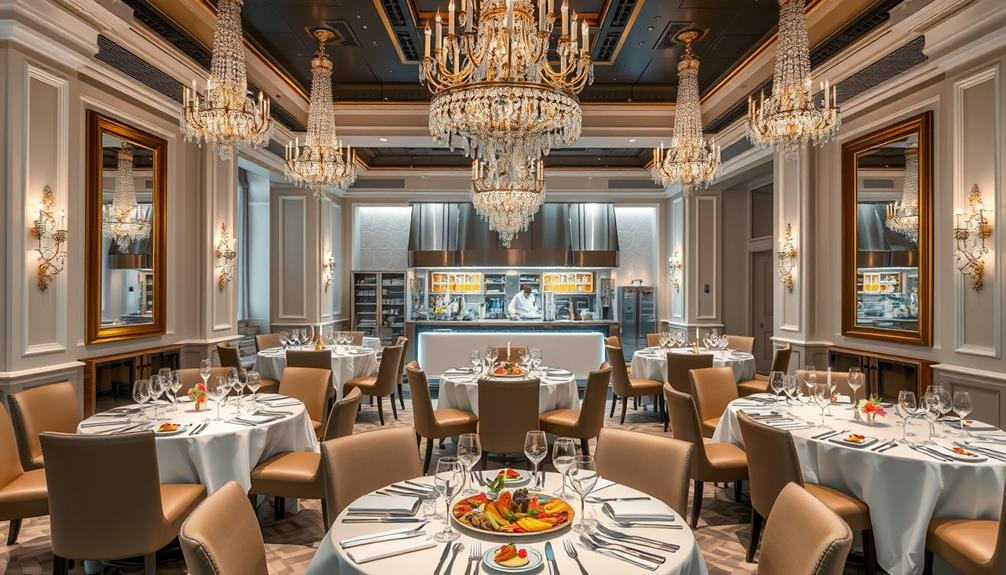
Across the globe, 145 restaurants have achieved the prestigious distinction of three Michelin stars, showcasing exceptional dining experiences that are truly worth a special journey. These notable establishments represent a diverse array of culinary traditions, highlighting the global diversity in exceptional cuisine.
For instance, the joy and nostalgia often found in Blue Skies and Lemonade by Rhythm Failure can be paralleled with the warm and inviting atmospheres of these culinary gems.
In Italy, La Pergola stands out for its outstanding culinary excellence, offering a menu that delights and surprises. Meanwhile, Aqua in Germany, led by the talented Chef Sven Elverfeld, continues to impress diners with its innovative dishes.
If you find yourself in Tokyo, you'll witness the city's reputation as the world's starriest, boasting multiple three-star restaurants that exemplify high culinary standards.
Spain's El Celler de Can Roca takes pride in its innovative approach to dining, earning its place among the elite three-star establishments. Additionally, the recent achievement of Ana Roš, the first Slovenian chef to earn three Michelin stars, showcases how the culinary world continues to evolve and expand its horizons.
Whether you're exploring these notable restaurants or dreaming of visiting them, the allure of three Michelin stars promises an unforgettable experience.
Recent Trends in Michelin Ratings
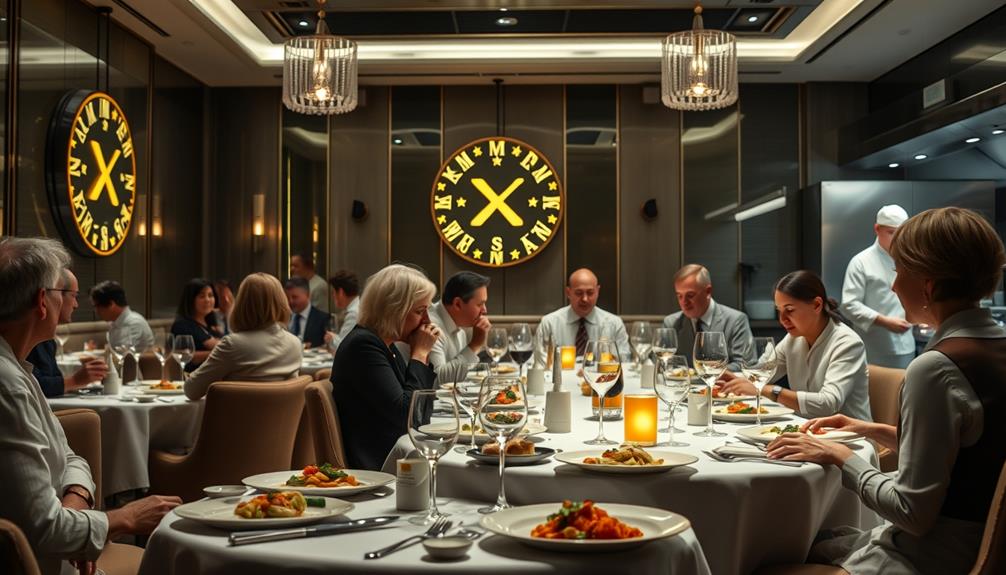
Michelin ratings are evolving, reflecting broader trends in the culinary world. As of 2024, 145 restaurants globally boast three Michelin stars, a demonstration of exceptional cuisine that's worth a special journey.
One significant trend is the rise of female chefs achieving this prestigious status, showcasing an exciting shift toward greater gender diversity in high-end culinary recognition.
Additionally, sustainability practices are becoming increasingly important in Michelin-starred establishments. You'll notice many chefs prioritizing local ingredients and eco-friendly gastronomy, which the Guide is now highlighting in recent ratings. This focus not only enhances food quality but also aligns with modern diners' values.
The geographic reach of the Michelin Guide has also expanded, with new stars emerging in regions like Canada. Cities such as Toronto and Vancouver have seen a surge in Michelin-starred restaurants since 2020, reflecting a growing culinary scene in these areas.
Significantly, the 2021 Michelin Guide awarded its third star to AM by Alexandre Mazzia, emphasizing a recognition for innovative and contemporary culinary styles.
This evolution in ratings shows how the culinary landscape is changing, making it an exciting time for food enthusiasts everywhere.
Frequently Asked Questions
Can You Get a 5 Star Michelin?
You can't get a five-star Michelin rating. The Michelin Guide only awards up to three stars. Each star signifies a different level of excellence, focusing solely on the restaurant's food quality and dining experience.
Is It Possible to Have 4 Michelin Stars?
Imagine a culinary dream, where four stars shimmer just out of reach. You can't achieve that fourth Michelin star; the system's cap leaves you craving more, yet three stars shine like a beacon of excellence.
Do 5 Michelin Stars Exist?
You won't find five Michelin stars because the system caps at three. This prestigious rating signifies exceptional culinary excellence, and no restaurant has ever received more than three stars since the guide's establishment in 1931.
How Many Michelin 3 Star Restaurants Are There in the US?
Imagine a culinary treasure map, with 14 sparkling gems marking three-star restaurants across the U.S. You'll discover extraordinary dining experiences worth a special journey, like Alinea and L20, shining brightly in the gastronomic landscape.
Conclusion
So, there you have it! Whether you're dreaming of a three-star feast or just hoping to snag a solitary star for your cozy diner, remember that in the world of Michelin, it's not just about the food—it's about the theatrics, the impeccable service, and maybe a dash of pretentiousness. Who knew dining could feel like a high-stakes game show? So, next time you indulge, just pray your chef isn't having an off day! Bon appétit!


